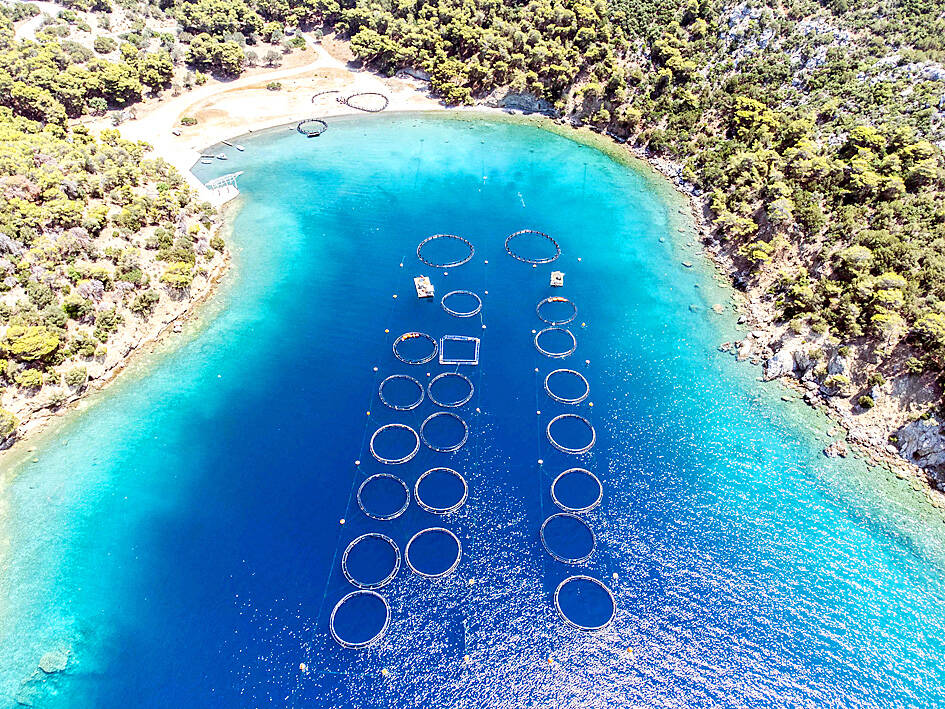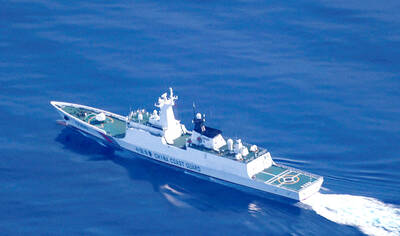A global target of having 30 percent of the oceans become protected areas by 2030 is looking more fragile than ever, with little progress and the US backing away, conservationists said.
“With less than 10 percent of the ocean designated as MPAs [marine protected areas] and only 2.7 percent fully or highly protected, it is going to be difficult to reach the 30 percent target,” said Lance Morgan, head of the Marine Conservation Institute in Seattle.
The institute maps the MPAs for an online atlas, updating moves to meet the 30 percent goal that 196 countries signed onto in 2022, under the Kunling-Montreal Global Biodiversity Framework.

Photo: AFP
The ambition is notably at risk, because “we see countries like the US reversing course and abandoning decades of bipartisan efforts” to protect areas of the Pacific Ocean, Morgan said.
That referred to an April executive order by US President Donald Trump authorizing industrial-scale fishing in big swathes of an MPA in that ocean.
There are 16,516 declared MPAs in the world, covering just 8.4 percent of the oceans.
However, not all are created equal: Some forbid all forms of fishing, while others place no roles, or almost none, on what activities are proscribed or permitted.
“Only a third of them have levels of protection that would yield proper benefits” for fish, said Joachim Claudet, a socioecology marine researcher at the French National Centre for Scientific Research.
Daniel Pauly, a professor of fisheries science at the University of British Columbia, said “the marine protected areas have not really been proposed for the protection of biodiversity,” but “to increase fish catches.”
A proper MPA “exports fish to non-protected zones, and that should be the main reason that we create marine protected areas — they are needed to have fish,” he said.
When fish populations are left to reproduce and grow in protected areas, there is often a spillover effect that sees fish stocks outside the zones also rise, as several scientific journals have noted, especially around a no-fishing MPA in Hawaiian waters that is the biggest in the world.
One 2022 study in the Science journal showed a 54 percent increase in yellowfin tuna around that Hawaiian MPA, an area now threatened by Trump’s executive order, Pauly said.
For such sanctuaries to work, there need to be fishing bans over all or at least some of their zones, Claudet said.
However, MPAs with such restrictions account for just 2.7 percent of the ocean’s area, and are almost always in parts that are far from areas heavily impacted by human activities.
In Europe, for instance, “90 percent of the marine protected areas are still exposed to bottom trawling,” said Alexandra Cousteau, a spokesperson for the non-governmental organization Oceana. “It’s ecological nonsense.”
Pauly said that “bottom trawling in MPAs is like picking flowers with a bulldozer... They scrape the seabed.”
Oceana said French MPAs suffered intensive bottom trawling, 17,000 hours’ worth last year, as did those in British waters, with 20,600 hours.
The NGO is calling for a ban on the technique, which involves towing a heavy net along the sea floor, churning it up. Governments need to back words with action, or else these areas would be no more than symbolic markings on a map, said Jacob Armstrong, head of the WWF’s European office for the oceans.

LANDMARK CASE: ‘Every night we were dragged to US soldiers and sexually abused. Every week we were forced to undergo venereal disease tests,’ a victim said More than 100 South Korean women who were forced to work as prostitutes for US soldiers stationed in the country have filed a landmark lawsuit accusing Washington of abuse, their lawyers said yesterday. Historians and activists say tens of thousands of South Korean women worked for state-sanctioned brothels from the 1950s to 1980s, serving US troops stationed in country to protect the South from North Korea. In 2022, South Korea’s top court ruled that the government had illegally “established, managed and operated” such brothels for the US military, ordering it to pay about 120 plaintiffs compensation. Last week, 117 victims

‘HYANGDO’: A South Korean lawmaker said there was no credible evidence to support rumors that Kim Jong-un has a son with a disability or who is studying abroad South Korea’s spy agency yesterday said that North Korean leader Kim Jong-un’s daughter, Kim Ju-ae, who last week accompanied him on a high-profile visit to Beijing, is understood to be his recognized successor. The teenager drew global attention when she made her first official overseas trip with her father, as he met with Chinese President Xi Jinping (習近平) and Russian President Vladimir Putin. Analysts have long seen her as Kim’s likely successor, although some have suggested she has an older brother who is being secretly groomed as the next leader. The South Korean National Intelligence Service (NIS) “assesses that she [Kim Ju-ae]

In the week before his fatal shooting, right-wing US political activist Charlie Kirk cheered the boom of conservative young men in South Korea and warned about a “globalist menace” in Tokyo on his first speaking tour of Asia. Kirk, 31, who helped amplify US President Donald Trump’s agenda to young voters with often inflammatory rhetoric focused on issues such as gender and immigration, was shot in the neck on Wednesday at a speaking event at a Utah university. In Seoul on Friday last week, he spoke about how he “brought Trump to victory,” while addressing Build Up Korea 2025, a conservative conference

China has approved the creation of a national nature reserve at the disputed Scarborough Shoal (Huangyan Island, 黃岩島), claimed by Taiwan and the Philippines, the government said yesterday, as Beijing moves to reinforce its territorial claims in the contested region. A notice posted online by the Chinese State Council said that details about the area and size of the project would be released separately by the Chinese National Forestry and Grassland Administration. “The building of the Huangyan Island National Nature Reserve is an important guarantee for maintaining the diversity, stability and sustainability of the natural ecosystem of Huangyan Island,” the notice said. Scarborough